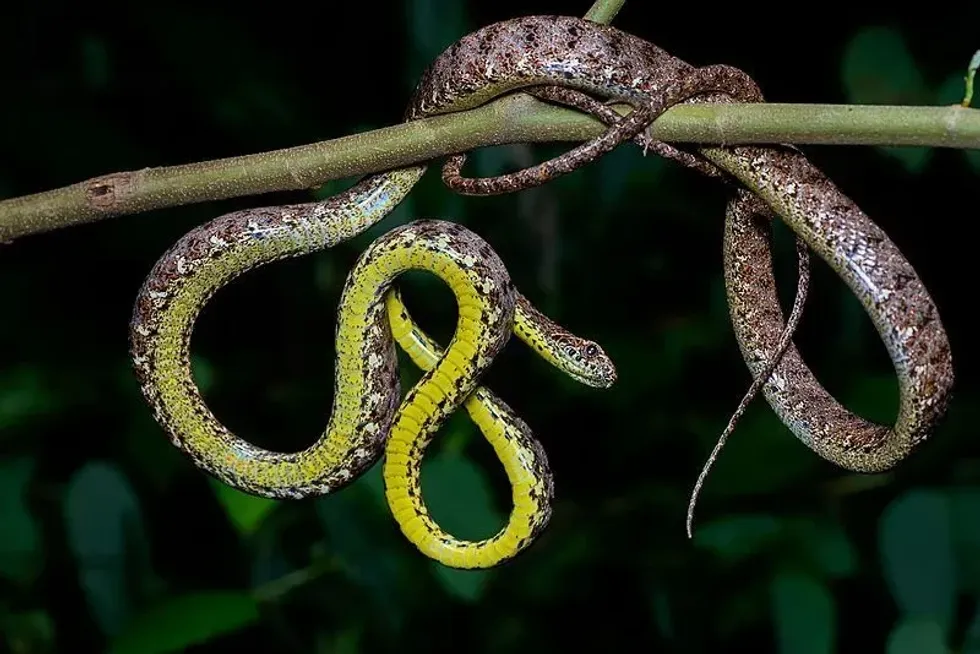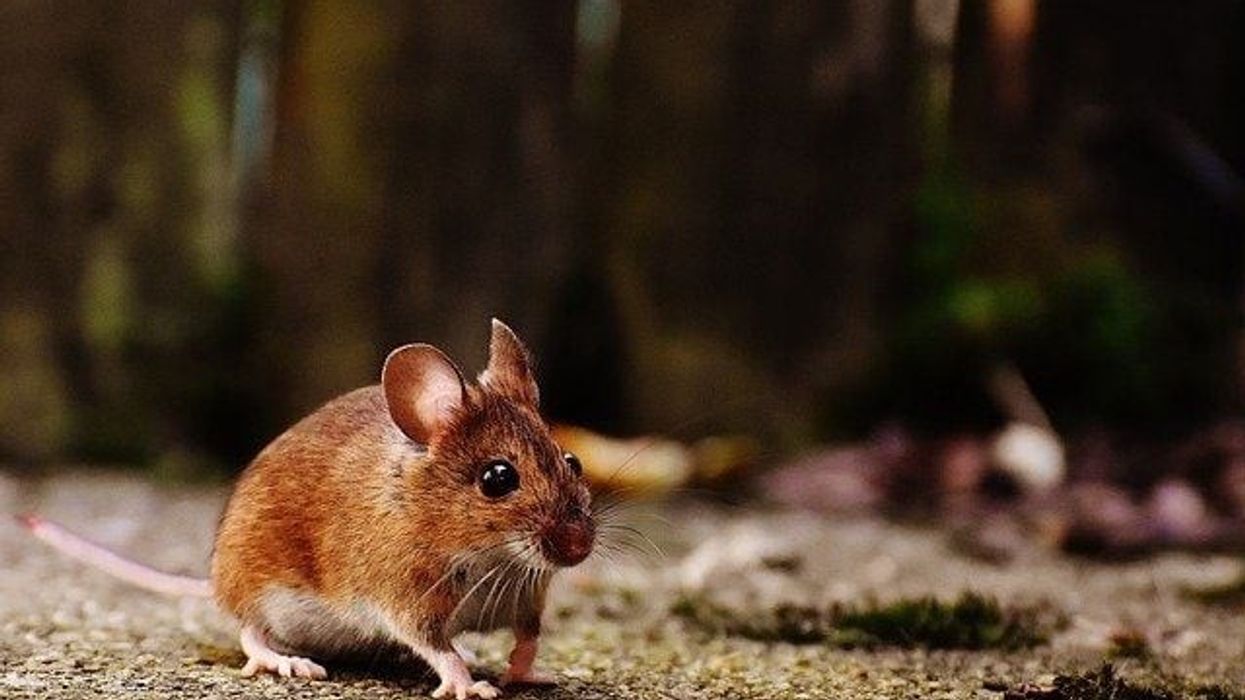The European Cat Snake is known as a cat-eyed snake of genus Boiga. They are known as Cat Snakes as they have vertical pupils like cats. There are 35 different known subspecies of Cat Snake with little variation in their characteristics. Some Cat Snakes have banding, some are spotted, and some are solid colored.
Their colors are normally brown, black, green with white or yellow accents. They are highly adaptive snakes. Some species are found in rainforests in humid weather or in mangrove swamps, grasslands, open woodlands.
These large headed and large eyed arboreal snakes do not like colder climates. They are found in Australia, India, Southeast Asia, and Africa.
The Boiga species are federally banned in the United States as they are considered to be highly invasive. In the 1950s, a single female snake with eggs was introduced on the island of Guam, which does not have a native snake population or predator that can deal with the Cat Snake’s size or aggressiveness.
Consequently, these large headed and large eyed snakes have bred unchecked and wreaked havoc with the bird species on the island.
Though, the European Cat Snake is not considered dangerous to humans as their rear fangs deliver mild venom only, which might cause some pain or discomfort, but is not dangerous to humans. Left unchecked, the population of Cat Snakes has increased in numbers, with 15000 snakes per square mile.
They are also causing other issues on the island. Due to their low toxicity venom, they have become a popular exotic pet species.
Read on for some of the most interested Cat eyed snake facts for your perusal. After reading the interesting northern Cat eyed snake facts, do check our other articles on hognose snake and gopher snake as well.
Cat Snake Interesting Facts
What type of animal is a Cat Snake?
The European Cat Snake is a type of snake found in various parts of the world due to its high adaptability. They are known for their large heads and large eyes that have vertical pupils like a cat, which expands at night to let more light in.
This is where they acquired their name. They are a large group of snake belonging to the genus Boiga.
What class of animal does a Cat Snake belong to?
The European Cat Snake (genus boiga) belongs to the class of reptiles. These large headed and large eyed snakes are oviparous like all reptiles and lay eggs. These snakes are active during the night.
How many Cat Snakes are there in the world?
The exact numbers of Cat Snakes in the world would be difficult to calculate as it has at least 35 known subspecies that are found in many different habitats across the world. Most species come under the least concern status on the IUCN Red list, which means their population is increasing and stable across various regions.
Where does a Cat Snake live?
The Cat Snake can be found in varied regions across the world. They are originally found in Australia, India, Southeast Asia, and some parts of Africa. These large headed and large eyed snakes are highly adaptable and have less venomous bites. They are popular as exotic pets across the world.
What is a Cat Snake's habitat?
Cat Snake habitats could be rainforest in humid weather or in mangrove swamps, grasslands, open woodlands. These arboreal snakes do not prefer colder climates. Cat-eyed snakes are found in a dry habitat.
Who do Cat Snakes live with?
Cat Snakes (Boiga) are solitary creatures and prefer to live alone. These large headed and large eyed snakes come together only for the purpose of mating.
How long does a Cat Snake live?
The Cat Snake lives for 12-15 years. This species with a large head and large eyes may live longer in captivity.
How do they reproduce?
Most boiga species lay 3-15 eggs. These large headed and large eyed snakes lay relatively smaller clutches.
Some species may lay their eggs in a cave or hollow of a tree or any such area where they won't dry out and there is no overheating. They may abandon their eggs in these areas which will hatch on their own after 90 days. Not much is known about their mating behavior and incubation period.
It may vary from species to species. Young ones are independent once hatched and receive no maternal care.
What is their conservation status?
Most boiga species come under the least concern status on the IUCN list, which means their population is increasing and stable. In certain areas, they are considered to be an invasive species which is affecting numbers of their predators in a negative manner.
Cat Snake Fun Facts
What do Cat Snakes look like?
Cat Snakes are arboreal species, which means this boiga reptile is tree-dwelling. These snakes are slender, medium to long, with a large head and big bulbous eyes with a vertical pupil.
They are opisthoglyphous or rear-fanged mildly venomous snakes. Some Cat Snakes have banding, while some are spotted, some are solid colored. The colors are brown, black, green with white or yellow accents
How cute are they?
Most people do not find snakes cute. But the boiga snakes are in demand across the world as exotic pets. Some people find them cute and like to have them as pets, too.
How do they communicate?
Boiga snakes may communicate only during the mating period. They are known to make hissing sounds.
How big is a Cat Snake?
Cat Snakes can grow to a length of 1.6-6.5 ft. Some species may grow to be about 9 ft long. The length of the snake may vary from species to species.
How fast can a Cat Snake move?
The Boiga Cat Snake can move at a speed of 12 mph. The speed of this Boiga species may vary depending on the terrain.
How much does a Cat Snake weigh?
The Boiga Cat Snake weighs around 1.1 lb. This might not be the same for all species. Like length, the weight may vary, too.
What are their male and female names of the species?
Cat Snakes do not have any specific names for males and females. The are called male Cat Snake and female Cat Snake, respectively.
What would you call a baby Cat Snake?
Baby Cat Snakes do not have any specific names.
What do they eat?
The Cat Snake diet includes lizards, other snakes, birds, frogs, small mammals, amphibians, and other reptiles. The Boiga will either subdue its prey with its venom or constrict its prey with its long body.
Are they poisonous?
The venom toxicity varies from species to species of the Cat Snake. But the venom is not considered life-threatening to a human. Their bite may be painful, though!
Would they make a good pet?
They are sold in markets as exotic pets. This light weight snake is high in demand in many parts of the world as they are highly adaptive. Boigas are kept in animal zoos, too. Cat Snakes do not like theextreme cold, they need a constant source of heat and light.
Did you know...
The Mangrove snake is one of the largest subspecies of Cat Snakes. It can grow up to 8 feet long. It has colorful black and yellow scales. As the name suggests, it can be found in the rainforest and mangroves habitat.
The Indian gamma snake is three feet long. They defend themselves from predators by looking like a highly venomous saw-scaled viper.
The brown tree snake is considered an invasive species on Gaum island. The native bird population has gravely decreased due to this species.
Naming the Cat Snake
The Cat Snake acquired its name because of its eyes which have a vertical pupil like a cat. They are also known as Boiga, which is the name of the species.
They are also called cat eyed snakes for the same reason. Each subspecies have their own name, too, like mangrove snake, common Cat Snake, black-headed Cat Snake, brown tree snake, Andaman Cat Snake, Sri Lankan Cat Snake, and many others.
Cat Snake bites
The venom toxicity may vary from species to species. But it is not harmful to humans. They do give a nasty bite. You may take paracetamol if you do get bitten. However, it is best to visit a doctor immediately and get treated.
Here at Kidadl, we have carefully created lots of interesting family-friendly animal facts for everyone to discover! Learn more about some other reptiles including water snake, or coral snake.
You can even occupy yourself at home by drawing one on our Cat snake coloring pages.










